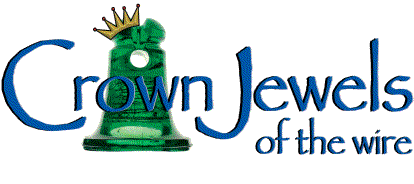MAC's Believe It Or Not!
Reprinted from "Crown Jewels of the Wire", September 1987, page 14
DOES THE NAME BARCLAY RING A BELL?
When I arrived at Houston's Hobby Airport, I was met by Mrs. Mac's hug and
kiss and an excited "you'll NEVER guess what insulator showed up here at
the Central Regional?!?!" This "BELIEVE IT OR NOT" story I share
with you with the assistance of N.R. Woodward:
Back in 1968 the publication, "Stuart's Insulator Guide" by Lynn R.
Stuart, featured an interesting insulator on page 37. The drawing appears to be
a CD 147; and, according to Mr. Stuart, it was embossed one half-mold BARCLAY,
opposite half-mold PATENTED OCT. 8th, 1907.

For a long time, most of us have assumed that his information was inaccurate
and that there was not in fact an insulator embossed with the Barclay name; and,
that the insulator was known by that name only because of its inventor, John C.
Barclay, who was chief engineer at Western Union during those years.
BELIEVE IT OR NOT, now comes the big surprise! At the Regional, Rob Lloyd
showed up with a real insulator that does indeed carry the BARCLAY name! It is
not, however, CD 147, but rather it is a CD 150. It is a Hemingray product with
DRIP POINTS, of ordinary Hemingray blue-aqua glass. On the opposite half-mold it
is embossed PATENTED OCT. 8 1907. Our specimen has considerable damage; even so,
it must be considered as being at or near the top for exciting finds in 1987.
From Rob Lloyd...."I was visiting an insulator collector friend in St.
Louis, Missouri, and took off walking to the grocery story which was about four
blocks away. I was intrigued by the CD 134 signal insulators which remained on
the old poles and had wired an old fire alarm circuit. Binoculars revealed what
appeared to be a CD 150 with SHARP DRIPS! Now, THAT would be something!
When it had finally gotten dark, I found myself under a streetlight
face-to-face with a CD 150 with sharp drips. No time for examination -- just get
that insulator off the pin!!! Into the bag, down the pole, onto the bike and
we're GONE! Back at the house, wash it up, and take a look at the prize. The
embossing was PATENTED OCT. 8 1907. Spinning the insulator around, I was
confronted with the word "BARCLAY." Then the shaking started. Pinch
me, I must be dreaming. Upon waking the next morning and finding the word
BARCLAY was still there on the insulator, my sense of being in a dream became
pure exhilaration. The real joy came as I shared my new "find" with
other collectors at the Central Regional Show."
As you can well imagine, this piece blew everyone away at the Pearland show.
I know that the insulator is damaged and a bit dirty (we had no solution with
which to safely clean the piece), but, "BELIEVE IT OR NOT" the piece
exists. The following pictures show comparison shots with the CD 147 and CD 150.

CD 150 front skirt BARCLAY compared to the CD 147 embossed PATENTED OCT. 8
1907. There is no embossing on the CD 147 rear skirt.

CD 150 rear skirt PATENTED OCT. 8 1907. compared to CD 147 embossed PATENTED
OCT. 8 1907. The embossing is identical and may have lead to the confusion. Note
that the embossing on the Brookfield CD 150 in the next pictures is slightly
different from the embossing on the BARCLAY.

CD 150 front skirt BARCLAY compared to CD 150 embossed BROOKFIELD/PAT. OCT.
8, 1907

CD 150 rear skirt PATENTED OCT. 8 1907. compared to CD 150 embossed
BROOKFIELD/PAT. OCT. 8, 1907 and there is no embossing on the rear skirt of the
piece on the right.
Now the question remains, did Mr. Stuart or one of his associates actually
see a BARCLAY back then? And, was it a CD 147 or CD 150? Do any of our long-time
collectors have the answer? "BELIEVE IT OR NOT!?!"
| 